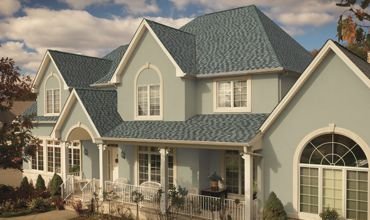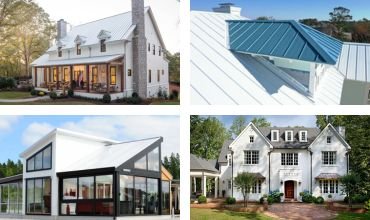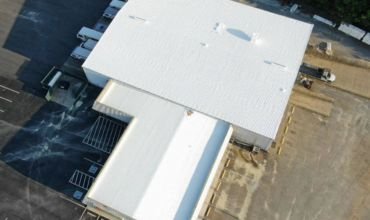Many people wonder, would a white roof cause winter to cost more? Well, it’s a common misconception that a white roof can increase your heating costs during the winter. While it’s true that white roofs are highly reflective of sunlight, this doesn’t necessarily lead to higher energy bills. This blog post will let you know about everything behind white roofs and their impact on energy consumption during winter.
We’ll get into the factors that affect heat transfer through roofs, including insulation, roof pitch, and climate conditions. Also, we’ll discuss the possible benefits of white roofs beyond energy savings, such as reducing urban heat island effects and improving air quality. Read on to get all the information here in this article.

Many residents go for a white roof, believing it will keep their homes cooler in the summer and warmer in the winter. While this assumption is partially correct, the reality is a bit more subtle when it comes to winter heating costs. You must know about the science behind roof color and its impact on energy savings.
The color of your roof plays a significant role in how it interacts with sunlight. Darker colors absorb more heat, while lighter colors reflect it. This property, known as albedo, is measured on a scale of 0 to 1, with 0 being completely black and 1 being perfectly white.
The color of your roof can also affect your home’s energy efficiency, resale value, etc. Have a look at these factors to consider when selecting a roof color:
Albedo, or the reflectivity of a roof material, impacts your home’s usage of energy. A lighter roof color, with a higher albedo, reflects more sunlight, keeping your home cooler during summer months and reducing air conditioning costs. But in colder climates, a darker roof can absorb more heat from the sun, lowering heating costs. Lighter colors are generally more suitable for regions with hot summers and mild winters, while darker colors can be beneficial in colder climates.

A well-chosen roof color can improve your home’s curb charm and increase its resale value. Neutral colors such as gray, brown, and black are more adaptable and demanding to a wider range of buyers. When selecting a roof color, think about the general architectural style of your area. A roof that complements the surrounding homes can help your property stand out positively.
Consider your personal preferences when selecting a roof color. Choose a shade that not only appeals to your eye but also blends with your home’s existing architectural style. A roof color that complements your home’s overall layout can sweeten its curb appeal and create an aesthetic.
If you plan to install solar panels, darker roof colors can improve their capability. Darker surfaces absorb more heat, which can help to warm up the panels and increase their energy output.
Local building codes may place restrictions on roof colors, especially in historic districts or neighborhoods with specific architectural policies. Before making a final decision, be sure to check with your local authorities.

White roofs come in various types, each with its unique features and benefits. Check out some of the common types:
It looks like regular asphalt shingles but have a reflective coating, and are easy to install and affordable. They’re compatible with most existing roofing systems. However, they may not be as durable or long-lasting as other types of shingles, and their reflective properties can fade over time.
These are made from reflective materials like aluminum or steel and are very stable. These roofs not only reduce energy costs but also help reduce urban heat island effects. While they may be more expensive to install than other options, their energy-saving and lastingness make them a profitable buy. To prevent heat loss in colder months, additional insulation may be necessary.
White coatings can be applied to existing asphalt shingle or metal roofs to increase their reflection. This is a cost-effective method to improve the energy efficiency of an existing roof. However, these may require regular maintenance and reapplication to maintain their reflective properties.
It’s made from synthetic materials and provides excellent reflectivity and stability. Highly resistant to fading and weathering, these coatings can greatly reduce energy costs. While they may be more expensive than standard coatings, their installation often requires specialized equipment.
Vegetated roofs, covered in plants, offer natural insulation and reduce heat absorption. These green roofs are highly environment friendly, improve air quality, and can help manage stormwater runoff. They require regular maintenance, such as watering and pruning, and may not be suitable for all climates.

White roofs have gained much popularity in recent years due to their numerous benefits, especially in regions with hot climates. By reflecting sunlight, white roofs can help reduce energy consumption, improve air quality, and contribute to a more sustainable environment. Its advantages include:

Commercial buildings, especially those located in regions with harsh winters, require specific roofing preparations to ensure their goodness and performance throughout the season. This involves thorough inspections to identify and address possible exposures such as cracks, leaks, or damage from previous weather events. Regular maintenance, including cleaning waste and inspecting flashing, is necessary to prevent water infiltration and ice buildup. By taking these steps for roofing winter preparation for commercial buildings, the owners can protect their property and lessen the risk of costly winter-related damage.
Now that you have a better understanding of white roofs and their impact on winter heating costs, it’s clear that the common misconception about them causing higher bills is largely unfounded. If you’re considering a new roof or looking to improve the energy saving of your existing one, a white roof is definitely worth exploring. To learn more about roofing options and to find a qualified roofing professional, contact Manage My Roof. The team of experts here can help you view your needs, suggest the best roofing materials for your home, and provide expert installation services.
No, it would not cost more, as it is noted as a misconception.
Yes, you can replace a roof in the winter, but it may be more challenging due to weather conditions.
Metal roofs, such as steel or aluminum, are often recommended for winter.
Yes, darker roofs can absorb more heat from the sun, reducing some heat loss.
Yes, some materials, like metal, can conduct heat more efficiently than others.
All you can do is regular inspections, clear debris, get insulation done, maintain proper ventilation & have a plan for snow removal.
Leave a Reply